One of the first projects I took on in bootcamp was helping to plan the next Buffer retreat. Along with my mentor, manager, and friend, Rodolphe, we started thinking about that retreat about a week after the Hawaii retreat wrapped up.
I’d love to take you through exactly how we planned Buffer’s 8th retreat, from start to finish, from an operations perspective. Let’s dive in!
Our Timeline for Buffer’s 8th Retreat in Madrid
Here’s a rough timeline of how things unfolded for the Madrid retreat so you can follow along. The retreat took place from February 25th – March 5th, 2017.
Late August 2016: Shortlist potential retreat dates, brainstorm potential locations
September 2016: Poll team on availability, shortlist locations for voting
October 2016: Confirm retreat dates, poll team on potential locations, identify top two location choices, source quotes from potential workspaces and hotels
November 2016: Identify potential retreat location, hotels, and workspaces, scouting trip to Madrid and Lisbon, confirm location, commence retreat experience planning (swag, activities)
December 2016: Negotiate terms of the contract and place booking for hotel and workspace, reach out to teammates for important details (e.g. specific requests for rooms, dietary restrictions) and assist with flight booking, retreat swag orders, planning of activities, ship first iteration of schedule.
January 2017: Check in and arrival information, communicate with workspace for booking of venues and hosting of events, confirmation of activities (company-wide and team-specific), refine retreat schedule.
February 2017: Finalize retreat schedule, ensure all the logistics are good to go, an early arrival in Madrid to get things in order.
Key takeaway: It took us 6 months to plan a retreat for a fully remote team and their families; 9 months would have been much more comfortable.
Starting out: When Will We Have The Retreat?
We initially planned to have in Berlin in August of 2016, eight months after the previous retreat. In the past, we have had retreats six or seven months apart so that our remote team never goes too long without some in-person time. (We take advantage of being in person for some long overdue hugs and lots of team brainstorming!)
In the end, our plans for Berlin got canceled due to our cash flow crisis in June is 2016. Planning for the Berlin retreat, though, helped us create a timeframe that we could follow in creating a plan for the next retreat, which we had in Madrid.
We had to strike a balance between having a retreat as early as possible to rebuild team morale after the layoffs and being sensible with our cash flow since we were still rebuilding our bank balance.
Retreats for a team our size are a huge expense, just last year in Hawaii the retreat was over $400,000. We took this into consideration, we wanted to be prudent and end up in as good a financial position as we could be.
We settled on having the retreat in February/March – just slightly more than a year after the Hawaii retreat, which is as far apart as we’re willing to have our retreats.
Research and planning began in September 2016 by starting to think of where we would all go.
Key takeaway: We try strike a balance between having retreats as often as possible, and being conscious of the financial cost.
How We Select Potential Locations
A supremely fun part of retreat planning is identifying potential locations. Past locations have been in Reykjavik, Cape Town, Sydney, and Hawaii. Early in the process, we created a Paper document as a brain dump for all the places that might:
- Accommodate a team of our size
- Be reasonably affordable
- Have an array of activity options for our diverse team
- Be safe for our teammates and any family members that might come along
As you can imagine, we had quite a list! To narrow this down, we did further research into:
- Potential cost of a retreat at each location (starting with flight and accommodation costs)
- Climate
- Logistics of a large retreat in each location
- Connectivity
Other considerations included minimizing time zone shifts and anticipating jet lag, family-friendly options, conference schedule, and festivals during the retreat dates.
Key takeaway: It helps to have criteria for selecting locations to guide the selection process. Criteria would tend to be quite specific to each remote company and would vary based on the scope of each retreat.
Deciding on the Location and Going on a Scouting Trip
After shortlisting five potential locations for our retreat, we polled the team for their preferences. The plan was to identify the top two choices from the team and pick one. But… we ended up with three top options with two cities tying for first place.
To narrow the list further, we reached out to various hotels and coworking spaces in each city to review our options. With the help from our teammates who live in each city, we also connected with an accelerator in Lisbon and Google Campus Madrid. After collating all the information we needed, it became clear that Lisbon and Madrid were the two more promising cities in our list.
If there’s one thing I can recommend to anyone planning a company retreat, it’d be this: try to make a scouting trip happen.
There’s nothing quite like being on the ground to get a sense of what each city might feel like for the folks on your team. I was grateful and excited to be the one headed on the scouting trip for Madrid and Liston.
Since the scouting trip accounted for a very small fraction (less than $2,500) of the overall cost of the retreat, I reckon it was a worthy investment for a huge expense like this. Drafting criteria for evaluating each hotel/workspace option also helped me make full use of my scouting trip!
Here’s what an example of the things I took scouting notes on for the Madrid retreat, I included a section for a rating and notes about specific remarks as well.
Criteria for our coworking space & hotel
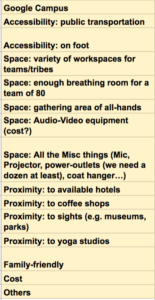
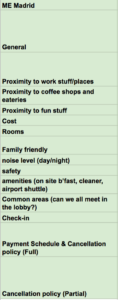
Click to see full size photos.
The scouting trip was essential in helping me get the lay of the land. The balance between the availability of dining options and coffee shops (coffee fuels many on the Buffer team!), workspace and hotel options, general walkability of the city, and family-friendliness of Madrid really contributed to our final decision to head there.
Key takeaway: Scouting trips are immensely useful!
Creating our Budget (and How Close we Were)
We may refer to a retreat budget, but to be perfectly transparent, we had about four of these throughout the entire process. Each budget was increasingly granular and accurate as we gathered more information along the way.
We’re currently running a comparison between the budget we set and the actual amount we spent and are excited to see what this looks like once we finish collating all the expenses, which we try to do in the first month after the retreat, but can sometimes take a bit longer.
Here are some elements of our budget:
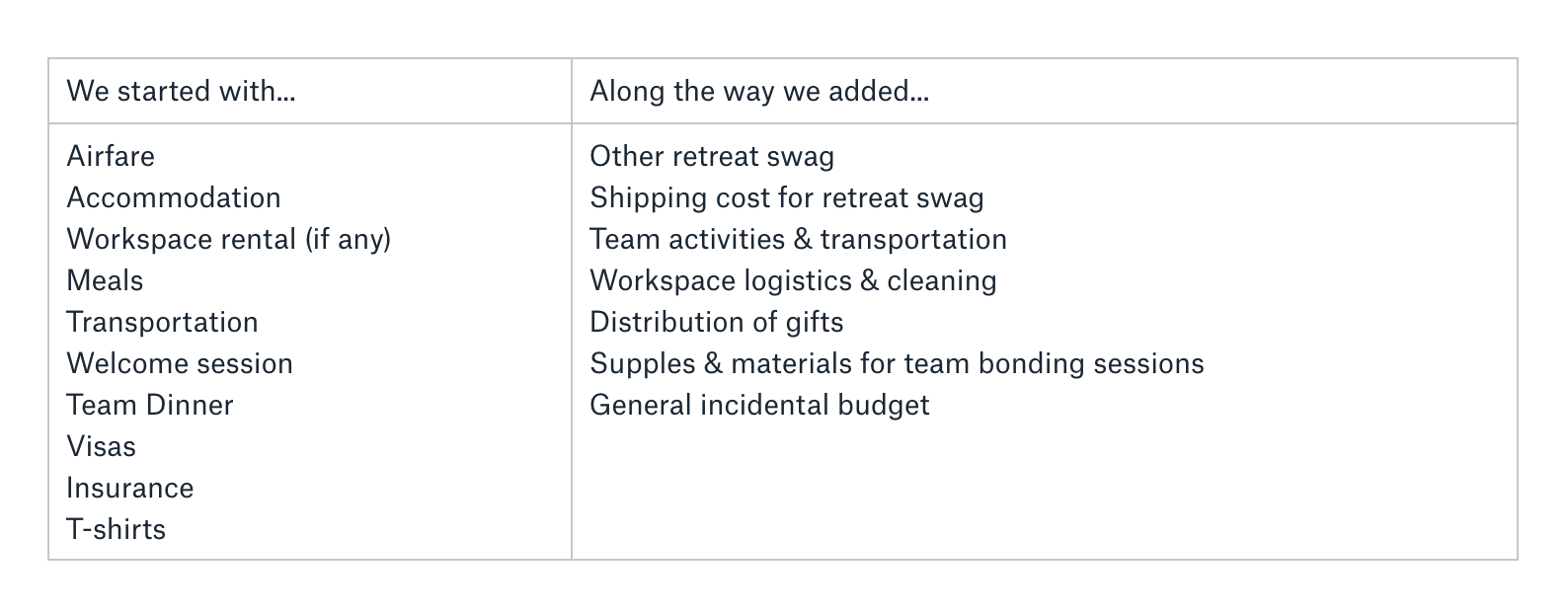
The stuff on the right can really sneak up on you, so it’s helpful to set aside a budget for them for the onset. I know we will for the next retreat!
Here’s our full budget from the retreat, along with a comparison of our actual spend.
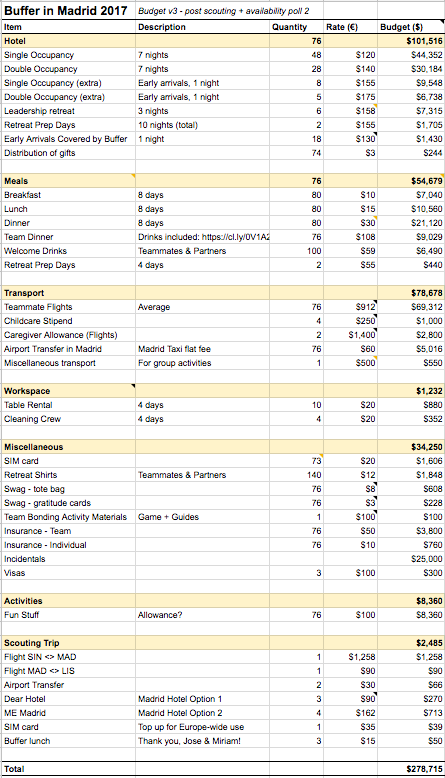
Key takeaway: Budgets are a great guideline though it helps to have some flexibility built in.
How We Scheduled Our Time Together
One of the big questions we tussled with while putting together the retreat schedule was how planned do we want this retreat to be?
This was an important one to consult and get advice on along the way, as there are convincing arguments to be made for both having a more free-form retreat and a very structured one. The former may encourage more serendipitous connections and the latter gives you more control over the outcome of the retreat. Both are great and work for different teams with different needs!
As we reflected, it became clear that there was a lot we wanted to do in this retreat – a year in a remote company can feel like a long time! Yet, we were keen to also use this retreat to practice our Buffer value of Living Smarter, Not Harder. Further, we have many introverts on our team, and it was important to us to build breathing room into the retreat, too.
The schedule we eventually arrived at was quite structured, and free time was mindfully built in, too.
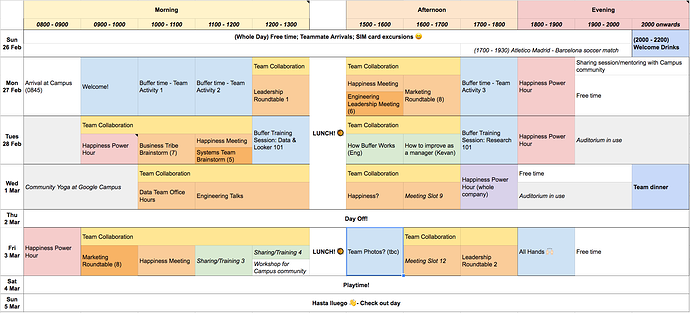

Other things we did to introduce breathing room into a structured schedule:
- Clearly identified which sessions everyone needed to be at, e.g. the All-Hands
- Reiterated which sessions were optional
- Encouraged the flexibility of taking an “introvert’s walk” in the middle of the day
- Posted team-specific schedules, so Bufferoos didn’t get overwhelmed looking at the master schedule
- Assigned sessions to teammates in the in-house retreat app that our mobile developers built for us
- Introduced Retreat Huddles and Guides to take some ad-hoc planning off teammates’ plates
Key takeaway: There’s no right or wrong way to design a schedule – each team has different needs, so it helps to listen first, and listen more ?
Finishing Touches and Next Steps
For me, retreat planning did not end with the retreat as there were loose ends to wrap up in the weeks that followed. We sent out a few surveys to team members and their partners and family who came on retreat. It also takes a little while to collect all of the expenses and charges. A key lesson for me here was building this part into the retreat planning schedule, too.
We’re currently working on an annual retreat schedule, so this has been helpful in framing the timeline for the 9th Buffer Retreat! We’re not quite sure where we’ll be heading or when but the People team is bubbling with excitement to get started.
Key takeaway: Remember to plan for the finishing touches that need to take place after the retreat as well.
Over to You
It has been more than a month since the 8th Buffer retreat in Madrid, and there are still random moments when I burst into laughter because of a funny memory from it. What an exhilarating week it was!
As one of only two Bufferoos in Singapore, it was an absolute treat meeting the whole team for the first time. It was a labor of love for the People team and I’m so grateful to have been part of that process.
I’d love to hear your story and chat in the comments!
- Have you planned a company retreat or are you going to?
- Have you ever been on a company retreat?
Try Buffer for free
190,000+ creators, small businesses, and marketers use Buffer to grow their audiences every month.



